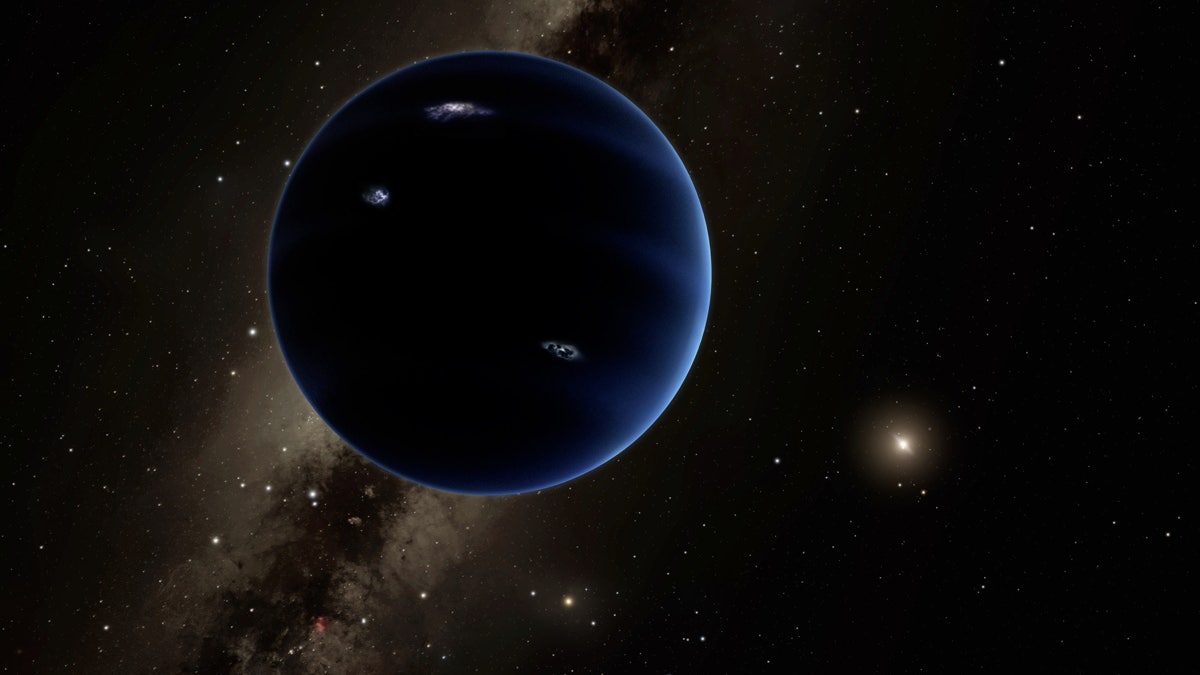Fox News Flash top headlines for Nov. 11
Fox News Flash top headlines for Nov. 11 are here. Check out what's clicking on Foxnews.com
Since its launch in April 2018, NASA's Transiting Exoplanet Survey Satellite (TESS) has found a number of exoplanets, including a so-called "missing link" and an exoplanet with three suns. But a new study suggests the $200 million satellite may have also discovered the mysterious Planet 9.
The research, published in Research Notes of the AAS, notes that TESS is able to take multiple images of the same spot in space, potentially locating trans-Neptunian objects, also known as TNOs.
Since TESS is able to detect objects at approximately 5 pixel displacement and Planet Nine "has an expected magnitude of 19 < V < 24," the possibility is raised "that TESS could discover it!" the authors wrote in the study.

Artist's illustration of Planet Nine, a hypothetical world that some scientists think lurks undiscovered in the far outer solar system. (R. Hurt (IPAC)/Caltech)
EVIDENCE FOR MYSTERIOUS PLANET NINE CONTINUES TO MOUNT, COULD BE 'SOLAR SYSTEM'S MISSING LINK'
"What TESS is doing is staring at regions in the sky for months for at a time," the study's lead author, Harvard University astrophysicist Matt Holman, said in an interview with Fox News. "It's looking for exoplanets and you can find those by looking at the paths of the host stars."
"While it's doing that, it's collecting images one at a time and it can look for objects in our solar system," Holman added. "The main thing I don't think people realized before is if you have a small telescope like TESS, you can combine images and find faint objects."
TESS is in space so it does not have to deal with the Earth's atmosphere getting in the way of its four cameras, Holman pointed out. "It's a stable platform."
The researchers tested the idea that TNOs can be found using predicted motion, adding in expected values of distance and orbit motion. They used software with three known TNOs, Sedna, 2015 BP519 and 2015 BM518, and found that it should work on any object with a near-infrared magnitude of approximately 21.
According to SyFy Wire, Planet 9 could have a near-infrared magnitude between 19 and 24, making it possible that TESS may have already observed it.
Holman noted that TESS has already looked at the entire southern hemisphere, making the chances "nearly 100 percent" that Planet 9 has already been observed if it's in that part of the sky. "If it's in the Northern Hemisphere, we're not there just yet," he added.
TESS, which launched in April 2018, replaced the Kepler telescope, which started to malfunction toward the latter part of last year and was eventually retired in October 2018 after discovering more than 2,600 exoplanets, including 18 Earth-sized exoplanets.
In September 2018, TESS found its first exoplanet. Seven months later, in April 2019, it found its first Earth-sized planet.
PLANET 9 MAY NOT BE A PLANET AT ALL, BUT RATHER A 'PRIMORDIAL BLACK HOLE,' SHOCKING STUDY SUGGESTS
Evidence of Planet Nine?
A hypothetical planet that has been described as "the solar system's missing link," Planet 9 (also known as Planet X) has been part of the lexicon for several years, first mentioned in 2014. It was brought up again in 2016, when Caltech astrophysicists Mike Brown and Konstantin Batygin first wrote about it.
THE HUNT FOR MYSTERIOUS PLANET 9
In October 2017, Batygin said that there are "five different lines of observational evidence" that point to the existence of Planet Nine.
The five lines of evidence are:
- Six known objects in the Kuiper Belt, all of which have elliptical orbits that point in the same direction.
- The orbits of the objects are all tilted the same way; 30 degrees "downward."
- Computer simulations that show there are more objects "tilted with respect to the solar plane."
- Planet Nine could be responsible for the tilt of the planets in our solar system; the plane of the planet's orbit is tilted about 6 degrees compared to the Sun's equator.
- Some objects from the Kuiper Belt orbit in the opposite direction from everything else in the solar system.
"No other model can explain the weirdness of these high-inclination orbits," Batygin said at the time. "It turns out that Planet Nine provides a natural avenue for their generation. These things have been twisted out of the solar system plane with help from Planet 9 and then scattered inward by Neptune."
In October 2017, NASA released a statement saying that Planet 9 might be 20 times further from the Sun than Neptune is, going so far as to say "it is now harder to imagine our solar system without a Planet 9 than with one."
Some researchers have suggested the mysterious planet may be hiding behind Neptune and it may take up to 1,000 years before it's actually found.
Two studies published in March 2019 offered support of its existence, however, a separate study published in September 2019 suggested the theoretical object may not be a giant planet hiding behind Neptune — but rather a primordial black hole.
A study published in January 2019 suggested that some of the farthest celestial bodies in our planetary system aren't being impacted by this yet-to-be-discovered planet, but rather another mysterious object deep in the echoes of space.
